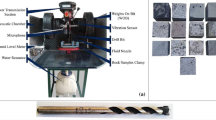Summary
Low Frequency Sounding Technique for Predicting Progressive Failure of Rock
The paper outlines the various techniques used for predicting failure of rock in open strip or underground mining operations. Changes occurring in mechanical parameters of rock on increase in stress and at failure are outlined. A new experimental technique is described, which is based upon detection of changes in the response of the rock mass to imposed very low frequency, low amplitude vibrations. The limitations of the existing equipment available for the purpose are outlined and the problems posed by the new technique discussed. The requirements of the system and the method of analysis are discussed. Results obtained on a gelatine model under laboratory conditions are described. These results clearly show that changes in the frequency and amplitude response of the model with developemnt of fractures can give advance indication of imminent failure.
Zusammenfassung
Ein Niederfrequenz-Schallverfahren zur Vorausbestimmung des progressiven Gesteinbruches
Die vorliegende Arbeit gibt in großen Zügen die verschiedenen Verfahren an, die zur Vorhersage des Versagens von Fels bei Obertage- und Untertagearbeiten Verwendung finden können. Die sich bei Spannungserhöhung sowie beim Zusammenbruch ergebenden Veränderungen der Gesteinsparameter werden im allgemeinen dargestellt. Ein neues, auf dem Nachweis der Veränderungen des Ansprechens von Fels auf induzierte Schwingungen sehr kleiner Frequenz und kleiner Amplitude beruhendes Prüfverfahren wird beschrieben. Die Grenzen der zur Zeit für diesen Zweck verfügbaren Apparatur werden angegeben, und die sich aus dem neuen Verfahren ergebenden Probleme werden besprochen. Die Voraussetzungen des Systems sowie der Analysenmethoden werden erörtert. Die an einem Gelatinemodell unter Laborbedingungen gewonnenen Ergebnisse werden beschrieben. Diese Ergebnisse zeigen deutlich, daß die bei der Bruchentwicklung vorkommenden Veränderungen des Frequenz- und Amplitudenansprechens des Modells einen vorläufigen Hinweis auf einen drohenden Gesteinszusammenbruch liefern können.
Résumé
Technique sonique à basse fréquence pour la prédiction de la fracture progressive de la roche
Cet article expose à grands traits les diverses techniques employées pour prédire des avaries de roche dans les exploitations minières à ciel ouvert ou souterraines. Les changements des paramètres de la roche pendant l'augmentation des contraintes et au moment de l'avarie sont indiqués. Une nouvelle technique expérimentale est décrite, elle est basée sur les changements de la réponse d'une masse rocheuse à la surimposition de vibrations de basse amplitude et de très basse fréquence. Les limitations de l'appareillage disponible pour ce but sont indiquées et les problèmes posés par la nouvelle technique sont discutés. Les exigences du système et la méthode d'analyse sont discutées. Des résultats obtenus au laboratoire avec un modèle en gélatine sont décrits. Ces résultats montrent clairement que les changements de la réponse à la fréquence et à l'amplitude du modèle développant des fractures peuvent donner à l'avance des indications d'une avarie imminente.
Similar content being viewed by others
References
Obert, L.: The Microseismic Method: Discovery and Early History. Proc. 1st Conf. Acoustic Emission/Micro-seismic Activity in Geologic Materials. Univ. Park, Pa., U. S. A. (Trans-Tech. Publications, Clausthal-Zellerfeld) (1975).
Hardy, H. R., Jr.: Emergence of Acoustic Emission Micro-seismic Activity as a Tool in Geomechanics. Proc. 1st Conf. on Acoustic Emission/Micro-seismic Activity in Geologic Materials, Univ. Park, Pa., U. S. A. (Trans. Tech. Publications, Clausthal-Zellerfeld) (1975).
Lama, R. D.: Analysis of Noise Associated With Rock Failure. Colliery Engng., pp. 155–157 (1967).
Antsyferov, M. S.: Seismo-acoustic Methods in Mining. N. Y. Consultants Bureau (1966), (Translated from Russian).
Kennedy, B. A.: Methods of Monitoring Open Pit Slopes. 13th Symp. Rock Mech., Urbana, Illinois, pp. 537–572 (1972).
Broadbent, C. D., and Ko, K. C.: Rheological Aspects of Rock Slope Failure. Proc. 13th Symp. Rock Mech., Urbana, Illinois, pp. 573–593 (1971).
Bieniawski, Z. T.: Mechanism of Brittle Fracture of Rock. Int. J. Rock Mech. Min. Sci.,4 pp. 395–430 (1967).
Fountain, L. S.: Evaluation of High Resolution Earth Resistivity Measurement Technique for Detecting Subsurface Cavities in a Granite Environment. Nat. Tech. Information Service, U. S. A. AD 018 281, 57 p. (1975).
Gates, D. C., and Armistead, R. A.: The Use of Advanced Technologies for Locating Underground Obstacles. Stanford Research Institute, Menlo Park, Stanford, Calif., Rep. 40, EPRI-78-20-0 (1974).
Timoshenko, W.: Vibration Problems in Engineering. D. Van Norstrand, New York (1928).
Wilkinson, J. H.: The Algebraic Eigen-value Problem. Oxford University Press, London (1965).
Frank, L. E.: Signal Theory. Prentice-Hall Inc., Englewood Cliffs, N. J., U. S. A. (1969).
Author information
Authors and Affiliations
Additional information
With 5 Figures
Rights and permissions
About this article
Cite this article
Allison, H., Lama, R.D. Low frequency sounding technique for predicting progressive failure of rock. Rock Mechanics 12, 79–97 (1979). https://doi.org/10.1007/BF01239951
Received:
Issue Date:
DOI: https://doi.org/10.1007/BF01239951




